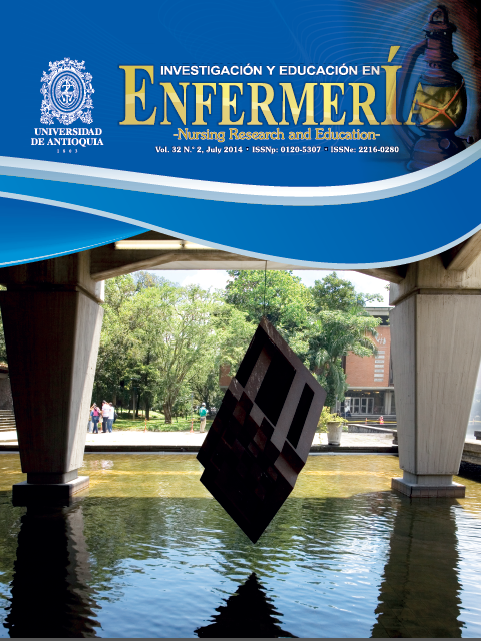The voice of children who live with HIV on implications of the disease in their daily life
DOI:
https://doi.org/10.17533/udea.iee.19970Keywords:
Child, acquired inmunodeficiency syndrome, HIV, nursing.Abstract
Downloads
References
(1) WHO/UNAIDS. Global report: UNAIDS report on the global AIDS epidemic 2012. Geneva: World Health Organization; 2012.
(2) Brasil, Ministério da Saúde. Secretaria de Vigilância em Saúde. Programa Nacional de DST/AIDS. Boletim Epidemiológico AIDS/DST. Brasília: Ministério da Saúde; 2012.
(3) Ceccato MGB, Acurcio FA, Bonolo PF, Rocha GM, GMDC. Compreensão de informações relativas ao tratamento antirretroviral entre indivíduos infectados pelo HIV. Cad Saúde Pública. 2004; 20(5):1388-97.
(4) Schaurich D, Coelho DF, Motta MGC. A cronicidade no processo saúde-doença: repensando a epidemia da AIDS após os antirretrovirais. Rev Enfermagem UERJ. 2006; 14(3):455-62.
(5) Pedro ENR. Vivências e (con)vivências de crianças portadoras de HIV/AIDS e seus familiares: implicações educacionais. [Dissertation]. Porto Alegre: Faculdade de Educação, PUC-RS; 2000.
(6) Botene DZA. As implicações da terapia antirretroviral no modo de viver de crianças com aids. [Dissertation]. Porto Alegre. Escola de Enfermagem, UFRGS; 2011.
(7) Coelho DF. A gestante portadora do vírus da imunodeficiência humana (HIV) percebendo sua corporeidade. [Dissertation]. Porto Alegre. Escola de Enfermagem, UFRGS; 2004.
(8) Oliveira RBG, Sparpani VC, Scochi CGS, Nascimento LC, Lima RAG. A entrevista nas pesquisas qualitativas de enfermagem pediátrica. Rev Bras Enferm. 2010; 63(2):300-6.
(9) Minayo MCS, Hartz ZMA, Buss PM. Qualidade de vida e saúde: um debate necessário. Ciênc. Saúde Coletiva. 2000; 5(1):7-31.
(10) Cruz EF. Infâncias, adolescências e AIDS. Educ. rev. 2007; 46:363-84.
(11) Motta MGC, Pedro ENR, Paula CC, Coelho DF, Ribeiro AC, Greff AP et al . O silêncio no cotidiano do adolescente com HIV/AIDS. Rev Bras Enferm. 2013; 66(3):345-50.
(12) Ayres PJR, França IJr, Paiva V. Crianças e jovens vivendo com HIV/Aids: estigma e discriminação. Rev. ComCiência SBPC/Labjor. [internet]. 2006 [cited 2012 Apr 7];76. Available from: http://www.comciencia.br/comciencia/handler.php?section=8&edicao=13&id=106&tipo=1.
(13) Freitas MI, Moreira OG. A experiência de mães soropositivas para hiv no período de espera de confirmação do diagnóstico do filho. Rev Min Enferm. 2007; 11(2):126-31.
(14) Kuyava J, Pedro ENR, Botene DZA. Crianças que vivem com aids e suas experiências com o uso de antirretrovirais. Rev Gaúcha Enferm. 2012; 33(3):58-64.
(15) Maliska ICA, Padilha MI, Vieira M, Bastiani J. Percepções e significados do diagnóstico e convívio com o HIV/aids. Rev Gaúcha Enferm. 2009; 30(1):85-91.
(16) Gomes AMT, Cabral IE. Ocultamento e silenciamento familiares no cuidado à criança em terapia antirretroviral. Rev Bras Enferm. 2010; 63(5):719-26.
(17) Feitosa AC, Lima HJA, Caetano JA, Andrade LM, Beserra EP. Terapia antirretroviral: fatores que interferem na adesão de crianças com HIV/AIDS. Esc. Anna Nery. 2008; 12(3):515-21.
(18) Agencia de Notícias da Aids. Anvisa aprova novo medicamento contra aids para crianças. Redação da Agência de Notícias da Aids. [Internet]. 2013 [cited 2013 jun 20]. Available from: http://www.agenciaaids.com.br/noticias/interna.php?id=20542
(19) Silva RAR, Rocha VM, Davim RMB, Torres GV. Ways of coping with AIDS: opinion of mothers with HIV children. Rev Latino-Am Enfermagem. 2008; 16(2):260-6.
(20) Bolono PF, Gomes RRFM, Guimarães MDC. Adesão à terapêutica anti-retroviral (HIV/aids): fatores associados e medidas de adesão. Epidemiol Serviços Saúde 2007; 16(4):261-78.
(21) Papalia DE, Olds SW, Feldman RD. Desenvolvimento Humano. 13th Ed. Porto Alegre: Artmed; 2013.
(22) Bragueto ACM. Crianças portadoras de HIV/Aids: Desenvolvimento emocional e social. [Dissertation]. Ribeirão Preto. Escola de Enfermagem de Ribeirão Preto, USP; 2008.
(23) Carvalho FT, Morais NA, Koller SH, Piccinini CA. Fatores de proteção relacionados à promoção de resiliência em pessoas que vivem com HIV/AIDS. Cad Saúde. 2007; 23(9):2023-33.
(24) Vieira MA, Lima RAG. Crianças e adolescentes com doença crônica: convivendo com mudanças. Rev Latino-Am Enfermagem. 2002; 10(4):552-60.
(25) Paula CC, Cabral IE, Souza IEO, Brum CN, Silva CB, Padoin SMM. HIV/AIDS in childhood and adolescence. Trends in Brazilian scientific production. Invest Educ Enferm. 2013;31(2):277-86.
Published
How to Cite
Issue
Section
License
Derechos de propiedad / Direitos de Propriedade
English: If the article is accepted for publication, all copyright will be of exclusive property of Investigación y Educación en Enfermería. The text and the graphics included in the publication are exclusive responsibility of the authors and not necessarily reflect the thought of the Editorial Committee.
Español: Si el artículo es aprobado para publicación, todos los derechos son de propiedad de Investigación y Educación en Enfermería. El texto y las gráficas incluidas en la publicación son de exclusiva responsabilidad de los autores y no necesariamente refleja el pensamiento del Comité Editorial.
Português: Se o artigo for aceito para publicação, todos os direitos autorais serão de propriedade exclusiva de Investigación y Educación en Enfermería. O texto e os gráficos incluídos na publicação são de responsabilidade exclusiva dos autores e não refletem necessariamente o pensamento do Comitê Editorial.















